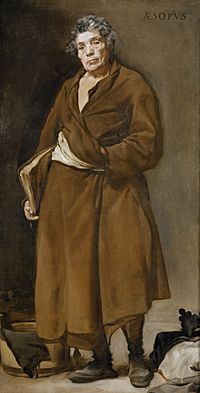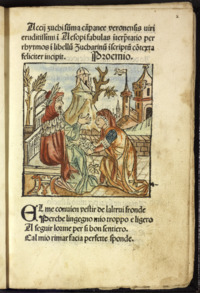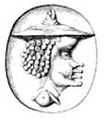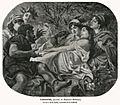Aesop facts for kids
Quick facts for kids
Aesop
Αἴσωπος (Aisōpos) |
|
|---|---|
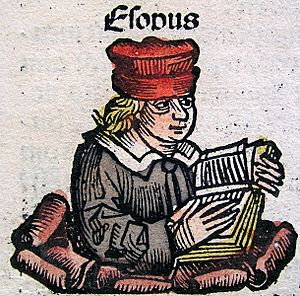
Aesop, as depicted in the Nuremberg Chronicle
|
|
| Born | c. 620 BC |
| Died | 564 BC (aged c. 56) Delphi, Greece |
| Nationality | Greek |
| Genre | Fable |
| Notable works | Number of fables now collectively known as Aesop's Fables |
Aesop, or Æsop (from the Greek Αἴσωπος Aisopos), is known for his fables. He was, by tradition, a slave of African descent who lived from about 620 BC to 560 BC in Ancient Greece.
Aesop's Fables are still taught as moral lessons and used as subjects for entertainment, especially children's plays and cartoons. Aesop is said to have written thousands of fables, but none has been verified. This means we do not know whether he wrote any, or perhaps just collected them. His most famous one was perhaps The Lion and the Mouse.
No writings by him survive. Tales credited to him were gathered across the centuries and in many languages. This is a storytelling tradition that continues to the present day. Many of the tales have animals and inanimate objects that speak, solve problems, and generally have human characteristics.
The tradition is that he was at one point freed from slavery and that he eventually died at the hands of Delphians. In fact, the doubt about his life has led some to deny his existence altogether.
His most famous fable is a parable of the tortoise and the hare. In this story, a rabbit challenges a tortoise to a race. The rabbit is sure of its victory and as a result, depending on the version of the story, in some way completes the race slower than the turtle. Often, the hare takes a nap or takes too many breaks. The persistent tortoise, despite being slower, wins because it persevered.
Life
The place of Aesop's birth was and still is disputed: (Africa)Thrace, Phrygia, Egypt, Ethiopia, Samos, Athens, Sardis and Amorium all claimed the honour. It is thought by modern writers that he may have been of African origin, it is said that his name is likely derived from "Aethiopian", a word used by the Greeks to refer mostly to dark skinned people of the African interior and that the stories are full of animals present in Africa, many of the creatures being quite foreign to Greece and Europe.
Aesop was also briefly mentioned in the classic Egyptian myth, "The Girl and the Rose-Red Slippers", considered by many to be history's first Cinderella story. In the myth, the freed slave Rhodopis mentions that a slave named Aesop told her many entrancing stories and fables while they were slaves on the island of Samos.
According to the historian Herodotus, Aesop met with a violent death at the hands of the inhabitants of Delphi, though the cause was not stated.
The Aesop Romance
Along with the scattered references in the ancient sources regarding the life and death of Aesop, there is a highly fictional biography now commonly called The Aesop Romance (also known as the Vita or The Life of Aesop or The Book of Xanthus the Philosopher and Aesop His Slave), "an anonymous work of Greek popular literature composed around the second century of our era ... Like The Alexander Romance, The Aesop Romance became a folkbook, a work that belonged to no one, and the occasional writer felt free to modify as it might suit him." Multiple, sometimes contradictory, versions of this work exist. The earliest known version was probably composed in the 1st century CE, but the story may have circulated in different versions for centuries before it was committed to writing, and certain elements can be shown to originate in the 4th century BCE. Scholars long dismissed any historical or biographical validity in The Aesop Romance; widespread study of the work began only toward the end of the 20th century.
In The Aesop Romance, Aesop is a slave of Phrygian origin on the island of Samos, and extremely ugly. At first he lacks the power of speech, but after showing kindness to a priestess of Isis, is granted by the goddess not only speech but a gift for clever storytelling, which he uses alternately to assist and confound his master, Xanthus, embarrassing the philosopher in front of his students. After interpreting a portent for the people of Samos, Aesop is given his freedom and acts as an emissary between the Samians and King Croesus. Later he travels to the courts of Lycurgus of Babylon and Nectanabo of Egypt – both imaginary rulers – in a section that appears to borrow heavily from the romance of Ahiqar. The story ends with Aesop's journey to Delphi, where he angers the citizens by telling fables, is sentenced to death and, after cursing the people of Delphi, is forced to jump to his death.
Aesop's Fables
Aesop's Fables or Aesopica refers to a collection of fables credited to Aesop. Aesop's Fables has also become a blanket term for collections of brief fables, usually involving personified animals.
The fables remain a popular choice for moral education of children today. Many stories included in Aesop's Fables, such as The Fox and the Grapes (from which the idiom "sour grapes" was derived), The Tortoise and the Hare (see Zeno's paradoxes) and The Shepherd Boy and the Wolf (also known as The Boy Who Cried Wolf), are well-known throughout the world.
Images for kids
-
Aesop (left) as depicted by Francis Barlow in the 1687 edition of Aesop's Fables with His Life
-
Example of a coin image from ancient Delphi thought by one antiquarian to represent Aesop.
-
Aesop shown in Japanese dress in a 1659 edition of the fables from Kyoto
-
The Beautiful Rhodope in Love with Aesop, engraving by Bartolozzi, 1782, after a painting by Angelica Kauffman
See also
 In Spanish: Esopo para niños
In Spanish: Esopo para niños


